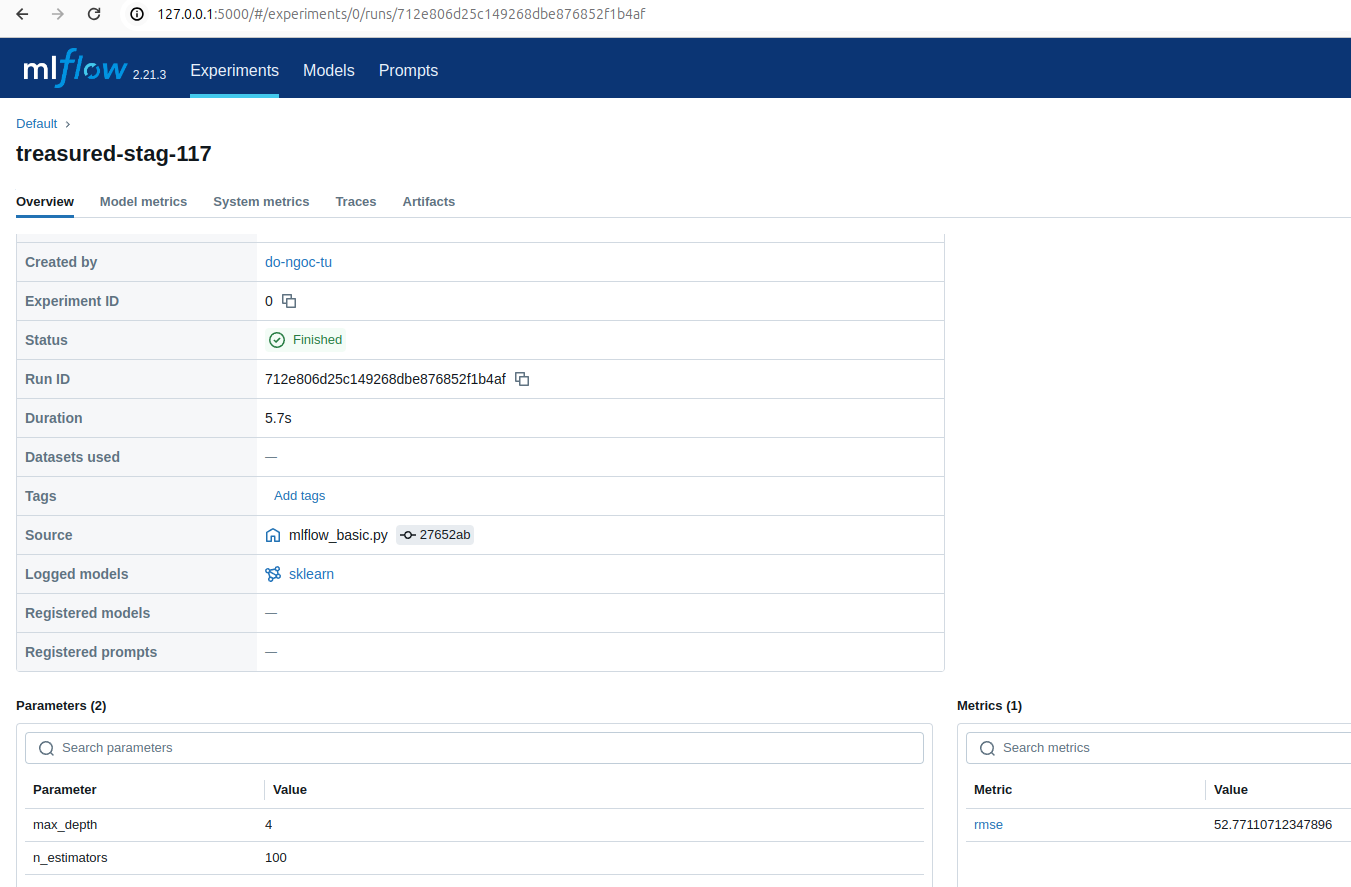Bài thực hành cơ bản nhất
Dưới đây là một bài thực hành MLflow cơ bản nhất, cùng với hướng dẫn cách xem giao diện MLflow UI.
Mục tiêu:
-
Hiểu cách ghi lại (log) các tham số, metric và mô hình bằng MLflow.
-
Chạy MLflow UI để xem kết quả trực quan.
I. Cài đặt MLflow
python3 -m venv venv
source venv/bin/activate
pip install mlflow scikit-learn pandas
II. Tạo file mlflow_basic.py
# mlflow_basic.py
import mlflow
import mlflow.sklearn
from sklearn.ensemble import RandomForestRegressor
from sklearn.metrics import mean_squared_error
from sklearn.datasets import load_diabetes
from sklearn.model_selection import train_test_split
import pandas as pd
# Load dataset
data = load_diabetes()
X = pd.DataFrame(data.data, columns=data.feature_names)
y = pd.Series(data.target)
# Train-test split
X_train, X_test, y_train, y_test = train_test_split(X, y, test_size=0.2, random_state=42)
# Bắt đầu một MLflow run
with mlflow.start_run():
# Tham số mô hình
n_estimators = 100
max_depth = 4
# Log parameters
mlflow.log_param("n_estimators", n_estimators)
mlflow.log_param("max_depth", max_depth)
# Train model
model = RandomForestRegressor(n_estimators=n_estimators, max_depth=max_depth)
model.fit(X_train, y_train)
# Predict & evaluate
predictions = model.predict(X_test)
rmse = mean_squared_error(y_test, predictions, squared=False)
# Log metrics
mlflow.log_metric("rmse", rmse)
# Log mô hình
mlflow.sklearn.log_model(model, "model")
print(f"Done! RMSE: {rmse}")
III. Chạy file
python mlflow_basic.pywarnings.warn( 2025/04/23 00:10:40 WARNING mlflow.models.model: Model logged without a signature and input example. Please setinput_exampleparameter when logging the model to auto infer the model signature.
Cập nhật đoạn log_model() như sau:
import numpy as np
# Log mô hình kèm input_example
mlflow.sklearn.log_model(
model,
artifact_path="model",
input_example=X_test.iloc[:5], # hoặc: X_test[:1]
signature=mlflow.models.infer_signature(X_test, predictions)
)
Giải thích:
-
input_example: Một ví dụ dữ liệu đầu vào cho mô hình. MLflow dùng nó để minh họa cách input phải như thế nào. -
signature: MLflow sẽ tự động suy luận kiểu input/output của mô hình.
IV. Xem giao diện MLflow UI
mlflow uiMLflow sẽ chạy trên http://127.0.0.1:5000 (mặc định). Mở trình duyệt và truy cập vào địa chỉ đó.
Click vào treasured-stag-117, bạn sẽ thấy
V. Tổng quan: "Log" trong MLflow nghĩa là gì?
Trong MLflow, "log" nghĩa là ghi lại và lưu trữ các thông tin như:
| Loại thông tin | Ví dụ | MLflow gọi là |
|---|---|---|
| Tham số (số lớp, số cây, learning rate, v.v.) | n_estimators=100 |
log_param |
| Kết quả đánh giá mô hình | rmse=54.772 |
log_metric |
| Mô hình đã huấn luyện | file .pkl hoặc .joblib |
log_model |
Ở ví dụ trên dùng RandomForestRegressor, mình sẽ ghi lại:
1. Tham số (Parameters)
mlflow.log_param("n_estimators", n_estimators)
mlflow.log_param("max_depth", max_depth)Ghi lại cấu hình mô hình để sau này dễ tái hiện.
2. Metric (hiệu suất mô hình)
rmse = mean_squared_error(y_test, predictions, squared=False)
mlflow.log_metric("rmse", rmse)Ghi lại giá trị RMSE để so sánh nhiều mô hình với nhau.
3. Ghi lại mô hình đã huấn luyện
mlflow.sklearn.log_model(model, "model")MLflow sẽ lưu mô hình để sau này có thể load lại, dùng để deploy, hoặc tái huấn luyện.
Tất cả đặt trong 1 "Run"
MLflow cần phải có 1 "chạy thử nghiệm" (run) để lưu trữ thông tin:
with mlflow.start_run():
# log_param()
# log_metric()
# log_model()
Tóm tắt chúng ta đã học
| Bạn muốn... | Dùng hàm... |
|---|---|
| Ghi lại một tham số | mlflow.log_param(name, value) |
| Ghi lại một kết quả đánh giá | mlflow.log_metric(name, value) |
| Ghi lại mô hình đã huấn luyện | mlflow.sklearn.log_model(model, "model") |
| Bắt đầu một "chạy thử nghiệm" | with mlflow.start_run(): |
Tác giả: Đỗ Ngọc Tú
Công Ty Phần Mềm VHTSoft



Không có bình luận